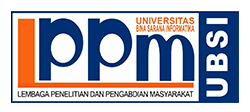Wisata Kuliner Sebagai Strategi Penguatan Pariwisata Di Kota Yogyakarta, Indonesia
Sari
Abstrak - Kota Yogyakarta merupakan tujuan pariwisata yang berkarakteristik pariwisata kota, yakni menawarkan daya tarik Kota yang dikemas dalam berbagai paket pariwisata. Kota Yogyakarta menjadi penyangga bagi destinasi wisata disekitarnya, yang menawarkan daya tarik wisata alam. Wisata kuliner menjadi strategi yang tepat dalam pengembangan pariwisata di kota Yogyakarta sebagai upaya mewujudkan pariwisata berkelanjutan, karena tidak memiliki potensi wisata alam. Penelitian ini merupakan penelitian deskriptif kualitatif, yang bertujuan menggali potensi wisata kuliner untuk memperoleh gambaran secara komprehensif tentang pengelolaan wisata kuliner di Kota Yogyakarta sebagai dasar perumusan program, strategis dan rencana aksi. Data primer dikumpulkan melalui forum group discussion untuk menggali informasi dari para stakeholder, sedangkan verifikasi data dilakukan dengan cara uji petik. Data dianalisis melalui proses reduksi untuk menghasilkan program-program prioritas dan rencana aksi untuk percepatan pengembangan wisata kuliner di Kota Yogyakarta.
Kata Kunci : Wisata Kuliner; Pariwisata Kota; Gastronomy; Storytelling
Culinary Tourism as a Strategy for Strengthening Tourism in the City of Yogyakarta,Indonesia
Abstract - Yogyakarta City is a tourism destination that is characterized by city tourism, which offers City attractions that are packaged in various tourism packages. The Yogyakarta city is a buffer for nearby tourist destinations, which offer natural tourist attractions. Culinary tourism is the right strategy in developing tourism in the Yogyakarta city as an effort to create sustainable tourism, because it does not have the potential for nature tourism. This research is a qualitative descriptive study, which aims to explore the potential of culinary tourism to obtain a comprehensive picture of culinary tourism management in the Yogyakarta city as a basis for program formulation, strategic and action plans. Primary data are collected through group discussion forums to gather information from stakeholders, while data verification is done by means of quotation tests. Data were analyzed through the reduction process to produce priority programs and action plans to accelerate the development of culinary tourism in the Yogyakarta city.
Keywords : Culinary Tourism; City Tourism; Gastronomy; Storytelling
Teks Lengkap:
PDFReferensi
Ab Karim, S & Christina, G.C. 2010. Culinary Tourism as a Destination Attraction: An Empirical Examination of Destinations' Food Image. Journal of Hospitality Marketing & Management, 19:531–555, 2010.
Basman, V. (2011). Food and Stories: An Interpretive Opportunity. Legacy Magazine, 22
Boniface, P. (2003). Tasting tourism—travelling for food and drink: New directions in tourism analysis.London, England: Ashgate.
Boyne, S., Williams, F., & Hall, D. (2002). The Isle of Arran taste trail. In A. M. Hjalager & G. Richards (Eds.), Tourism and gastronomy (pp. 91–114). London, England: Routledge.
Chatzinakos, G. (2016). Exploring Potentials for Culinary Tourism through a Food Festival The Case of Thessaloniki Food Festifal. Transnational Marketing Journal, 4(2), 110-125. Transnational Press London,
Chow, D., & Lim, J. (2014). Ottawa Food: A Hungry Capital. Ontario: Arcadia Publishing
Caldwell, M. (2006). Tasting the world of yesterday and today: culinary tourism and nostalgia foods in Post-Soviet Russia. In R. Wilk (Ed.), Fast Food/Slow Food: The Cultural Economy of the Global Food System (pp. 97–112). Lanham: AltaMira Press.
Correia, A., Moital, M., Da Costa, C. F., Peres, R. (2008). The determinants of gastronomic tourists’ satisfaction. Journal of Food Service, 19, 164-176.
Ellisa, A., Eerang, P., Sangkyun, K., Ian, Y. (2018).What is food tourism?. Tourism Management, 68, 250-263.
Hall, C. M. and Mitchell, R. (2001). Wine and food tourism. In Special Interest Tourism: Context and Cases (Douglas, N., Douglas, N. and Derrett,R., eds), pp. 307 329, Wiley.
Hall, M., & Sharples, L. (2003). The consumption experiences or the experience of consumption: An introduction to the tourism of taste. In by C. M. Hall, L. Sharples, R. Mitchell, N. Macionis, & B. Cambourne (Eds.), Food tourism around the world: Development, management and markets (pp. 1–24). Oxford, England: Butterworth-Heinemann.
Hjalager, A., & Corigliano, M. (2000). Food for tourists—determinants of an image. International Journal of Tourism Research, 2(4), 281–293.
Hjalager, A.M., Richards, G. (2002). Still undigested: research issues in tourism and gastronomy. In A.M. Hjalager, G. Richards (eds.), Tourism and Gastronomy. London: Routledge.
Kivela, J., Crotts, J.C. (2005). Gastronomy Tourism. Journal of Culinary Science & Tourism, 4(2-3), 39-55.
Lin, Y.-C., Pearson, T. E., & Cai, L. A. (2010). Food as a form of destination identity: A tourism destination brand perspective. Tourism and Hospitality Research, 11(1), 30– 48. http://doi.org/10.1057/thr.2010.22
Long, L. (2004). Culinary tourism. Lexington, KY: The University Press of Kentucky.
Mason, M. C., & Paggiaro, A. (2009). Celebrating Local Products: The Role of Food Events. Journal of Foodservice Business Research, 12(4), 364–383. http://doi.org/10.1080/15378020903344323
Mitchell, R., & Hall, M. C. (2003). Consuming tourist: Food tourism consumer behaviour. In M. C. Hall, L. Sharples, R. Mitchell, N. Cambourne, & N. Macionis (Eds.), Food tourism around the world: Development, Management and Markets (pp. 60–80). Oxford: Butterworth-Heinemann.
Okumus, B., Okumus, F., & McKercher, B. (2007). Incorporating local and international cuisines in the marketing of tourism destinations: The cases of Hong Kong and Turkey. Tourism Management, 28(1), 253-261.
Pepela, A., & O’Halloran, R. M. (2014). Targeting Kenya’s coastal gastronomic market: An assessment of tourists’ demographics (in review).
Quan, S., & Wang, N. (2004). Towards a structural model of tourist experience: An illustration from food experiences in tourism. Tourism Management, 25, 297–305.
Richards, G. (2002). Gastronomy as a tourist product: the perspective of gastronomy studies. In Tourism and Gastronomy, A.M. Hjalager, G. Richards (Eds.), London: Routledge.
Rusher, K. (2003). The Bluff Oyster Festival and regional economic development: Festivals as culture commodified. In C. M. Hall, E. Sharples, R. Mitchell, B. Cambourne, & N. Macionis (Eds.), Food tourism around the world: Development, Management and Markets. Oxford: Butterworth-Heinemann.
Sengal, T,. Aysen, K., Gurel, C., Fusün, I.D., Suna, M.E., and Mehtab, B. 2015. Tourists’ Approach to Local Food. Procedia-Social and Behavioral Sciences 195, 429 – 437
Simeon, M. I., & Buonincontri, P. (2011). Cultural Event as a Territorial Marketing Tool: The Case of the Ravello Festival on the Italian Amalfi Coast. Journal of Hospitality Marketing & Management, 20(3–4), 385–406. http://doi.org/10.1080/19368623.2011.562425 Smith
Tikkanen, I. (2007). Maslow’s hierarchy and food tourism in Finland: five cases. British Food Journal, 109(9), 721–734. http://doi.org/10.1108/00070700710780698
Wagner, H. A. (2001). Marrying food and travel . . . culinary tourism. Canada’s Food News, Foodservice Insights, March
Wijayanti, A and Damanik, J. (2019). Analysis of the Tourist Experience of Management of a Heritage Tourism Product: Case Study of The Sultan Palace of Yogyakarta, Indonesia. Journal of Heritage Tourism. 14 (2), 166-177.
Wolf, E. (2002). Culinary Tourism: A Tasty Economic Proposition. International Culinary Tourism Task Force.
DOI: https://doi.org/10.31294/khi.v11i1.7998
====================================================================
Terbit setiap bulan Maret & September, ISSN : 2655-5433 (online)













